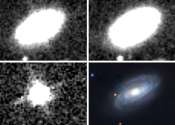Dwarf galaxies use 10-million-year quiet period to churn out stars
If you look at massive galaxies teeming with stars, you might be forgiven for thinking they are star factories, churning out brilliant balls of gas. But actually, less evolved dwarf galaxies have bigger regions of star factories, ...









